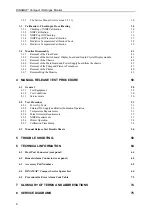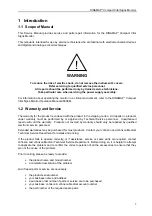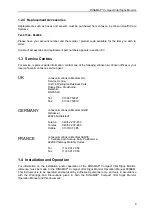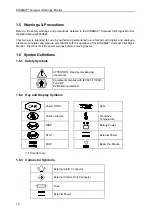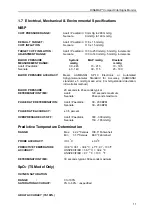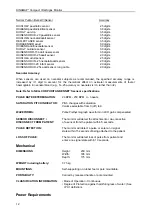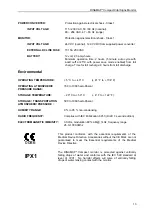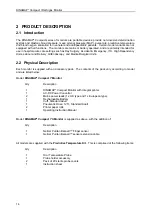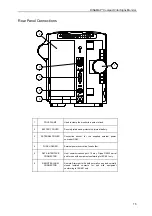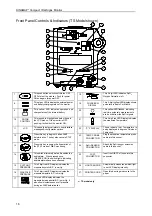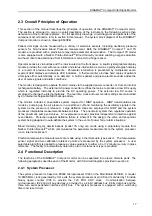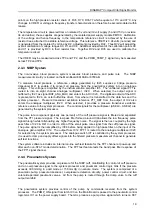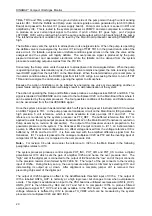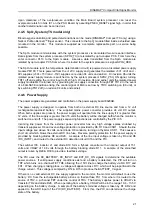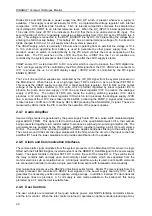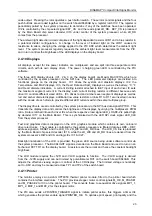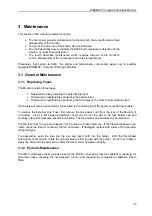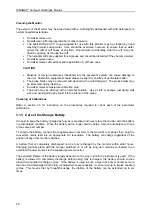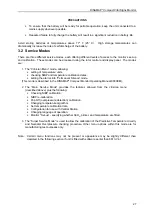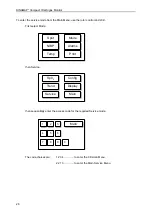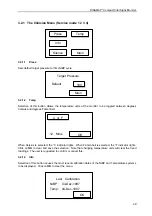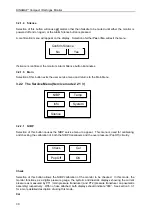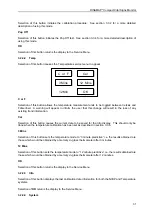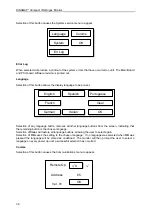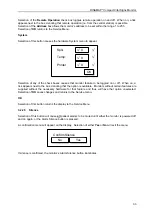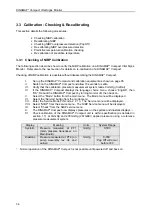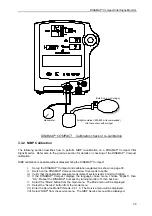
DINAMAP*
Compact
Vital Signs Monitor
20
TR4b, TR13 and TR8, pulling down the ground return side of the pump motor through current sensing
resistor R31. Both the Deflate and Dump valve control signals are also generated by latch IC3 (Main
Board) and passed to the GAL IC1 (power supply board). Pump motor current is sensed in R31 and
amplified by IC4. This is routed to the system processor as PUMPC and also compared to a reference
to produce an over current input signal to the GAL. If pin 9 of GAL IC1 goes high, pin 12 (signal
LATCHED_OVC) will be latched high and the pump enable output will go high switching off the pump.
The latched overcurrent condition can be reset by the Main Board processor asserting PNEURESET
high.
The Deflate valve vents the system to atmosphere in its energised state. When the pump is operating,
the deflate valve is de-energised by the GAL IC1 turning off FET TR1b in the ground return side of the
valve circuit. If a failsafe, overpressure or deflate condition signal arrives on the GAL, the valve will be
energised and the system will rapidly deflate. The over-pressure signal is produced by the pump
pressure transducer and associated electronics, while the failsafe can be derived from the system
processor’s watchdog output as well as from the PIC IC5.
Conversely, the Dump valve vents the system to atmosphere in its de-energised state. When the pump
is operating during a determination cycle, the Dump valve remains energised, the GAL receiving a high
level DUMP signal from the latch IC3 on the Main Board. When the determination cycle is complete, or
if an alarm condition arises, the DUMP signal from latch IC3 will go low causing the GAL to turn off FET
TR4a and de-energise the dump valve, opening the system to atmosphere.
Because the action of deflation can be initiated by energising one valve or de-energising another, a
power failure during a determination will always result in de-pressurisation of the system.
The action of operating the Dump and Deflate valves produces a voltage across R20/21 and R66. This
signal is labelled VALVESENSE and is routed to the multiplexer IC20 on the Main Board from where it
can be selected by the system processor. The four possible conditions of the Dump and Deflate valves
can be ascertained from the VALVESENSE signal.
Once the system processor has determined which cuff type is being used, it instructs latch IC3 to output
an ADULT signal to TR1. In the pump pressure transducer circuit on the Main Board, IC8 generates a
high precision 5 volt reference, which is made available to dual op-amps IC10 and IC21. This
reference is monitored by the system processor as PT2_REF. The buffered reference from IC21 is
applied to excite the pump output pressure transducer ML2 on the Main Board (Transducer mounted on
Pump assembly on revision 04 and earlier). The output of the transducer varies in proportion to the
pneumatic pressure in the system. The transducer ML2 output connects to IC11, an instrumentation
op-amp in differential mode configuration. An offset voltage derived from the voltage reference IC8 is
buffered by IC10b and fed to IC11 it is then summed with the amplified difference signal from the
transducer. IC11’s output is passed to the analogue multiplexer IC20 as PT2 and the inverting input of
comparator IC15a where it is compared to the over pressure limit.
Note:-
For revision 04 units and earlier the reference to IC25 on the Main Board in the following
paragraphs relates to IC10.
The system processor produces control signals POT_INC, POT_U/D and POT_CS to drive a digital
potentiometer IC13 which sets the gain of amplifier IC25a and hence the over pressure limit. The
“high” end of the digital pot is connected to the output of IC25a while the “low” end of the pot connects
to the precision resistor chain formed by R47,48 & 50. The “wiper” of the pot connects to the inverting
input of IC25a. During factory set-up, the over pressure alignment is trimmed by selecting IC13 and
incrementing its output up or down. After alignment is complete, jumper LK1 is removed, thus
preventing chip select of the digital pot.
The output of IC25b applies an offset to the Adult/Neonate threshold input of IC15a. The output of
IC15a, labelled UNFIL_OVP, is normally at a high logic level but changes to low when overpressure
occurs. This signal is available as an input to the PSU board as unfiltered overpressure (UNFIL_OVP).
UNFIL_OVP is then filtered by R49 and C27 and fed in to comparator IC15b to produce filtered
overpressure signal FLT_OVP and is made available to the PSU board. The overpressure threshold
voltage reference is buffered by IC12 to produce TH_VREF which can be measured by the system
processor via multiplexer IC20 and ADC IC23.

